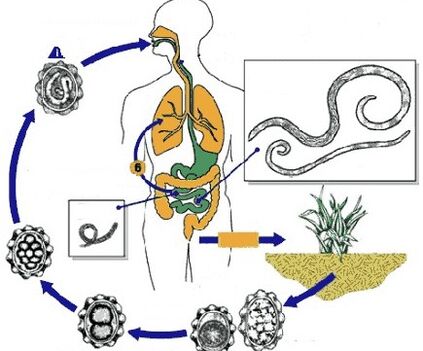
Helminthiasis is a group of parasitic diseases that progress as a result of the penetration of various types of parasitic worms into the body. These diseases are not limited in terms of sex and age. It should be noted that helminthiasis is more often diagnosed in children. This is due to the fact that children are less hygienic, eat unwashed food and often play in the fresh air (sandpit, garden, etc. ).
Helminths are a group of worms that can penetrate the human body and grow freely, thereby causing the development of parasitic diseases. All members of this group can be divided into 3 groups:
- roundworms;
- lent;
- fluctuates.
Depending on the mode of transmission, all human helminthiases are divided into:
- biohelminthiasis.In this case, the parasite is carried by animals;
- contagious.Infection occurs from a sick person;
- geohelminthiasis.This type of helminthiasis passes through the soil. This is because a certain part of the parasites' life cycle occurs in the soil.
Laras and developing parasitic forms are the most dangerous for the human body, because they can move freely in the body and infect vital organs. Adults cannot move so freely and therefore have a more stable position.
Most species of helminths "prefer" to parasitize in the gastrointestinal tract. It should be noted that different species are localized in different parts of the digestive tract: pinworms - in the lower part of the small intestine, roundworms - in the upper part, and so on. In addition, depending on the location, helminths are divided into tissue and luminal.
It should be noted that parasites can infect not only the digestive system, but also the lungs, bile ducts and gallbladder itself. They release various toxins that poison the human body throughout their lives. If you suspect the presence of parasites in the body, consult a doctor immediately and start treatment to prevent the development of dangerous complications.
Signs

The characteristic symptoms of helminthiasis are primarily seen in the peripheral blood. If you do a clinical analysis, you will find a significant increase in the number of eosinophils (especially in the acute phase of the disease). It should be noted that eosinophilia is often associated with severe leukocytosis.
Other helminth symptoms include:
- itching in the anus;
- Unstable stools are possible - constipation and diarrhea;
- sleeping stones;
- morning sickness. It often occurs in a person when brushing their teeth;
- weight loss without dietary changes;
- hyperthermia accompanied by joint and muscle pain;
- drown in the morning;
- a man is always hungry;
- appearance of rash elements on the skin (sometimes on the eyelids);
- The skin on the fingers breaks.
symptoms
The clinic of helminthiasis is divided into acute and chronic stages. The first symptoms of helminthiasis appear one month after the parasites enter the body. The acute phase of the pathological process begins. A person experiences the following symptoms:
- diarrhea;
- hyperthermia;
- inflammation of the upper respiratory tract;
- rash elements appear on the skin;
- conjunctivitis;
- face swells. This symptom manifests itself especially in children;
- Young children sometimes have tonsillitis and lymphadenitis.
The pathological process can be complicated:
- hepatitis;
- bronchospasm;
- appearance of infiltrates in the lungs;
- pneumonia;
- meningoencephalitis;
- myocarditis.
The above symptoms do not appear at the same time as any specific type of helminthiasis. In general, only two or three symptoms predominate in the clinic of the disease. In one patient, such a clinical picture is observed for 7 days, after which the disease becomes chronic. Pathological symptoms vary depending on the type of pathogen that parasitizes the human body:
- echinococcosis. An allergic reaction comes to the fore. Allergy symptoms are at an all-time high. In the most severe clinical conditions, even anaphylactic shock may develop;
- filariasis and strongiloidosis. The rash on the skin worsens and the face becomes swollen.
The manifestation of helminthiasis also depends mainly on the location of parasites. Most species parasitize the gastrointestinal tract, causing indigestion, weight loss, nausea, vomiting, and intoxication syndrome.
Experts refer to the most severe helminthiasis:
- echinococcosis;
- paragonimiasis;
- cysticercosis.
These helminthiases affect almost all vital organs and systems, so even with timely treatment, such a prognosis is often unfavorable.
Diagnostics
Due to the large number of helminthiases, diagnostics involves many research methods. The most informative and frequently used are:
- fecal analysis. Inside, doctors are able to detect helminth eggs and undigested food residues, indicating a disorder of the gastrointestinal tract;
- blood in microfilaria;
- to detect roundworms and worms in the human body, to apply for macroscopic examination;
- microscopic examination;
- bile research;
- coproovoscopy. Diagnosis of helminthiasis using this method allows to determine the intensity of helminthic invasion;
- examination of the composition of the duodenum;
- If doctors suspect that a person has developed trichinosis, a muscle tissue biopsy is prescribed;
- ultrasound;
- x-ray;
- fibrogastroduodenoscopy;
- Blood test for antibodies specific to some helminthiases.
Treatment
The main goal in the treatment of the disease is to remove parasites from the patient's body, as well as to restore the normal functioning of the gastrointestinal tract. The treatment plan is determined only by a qualified specialist after a thorough diagnosis and evaluation of test results. Treatment can be carried out both in a hospital setting and at home.
The basis of treatment of helminthiasis is the use of specific anthelmintic drugs.
These should only be taken in the dose prescribed by the attending physician. In the acute stage of the disease, a single dose of the drug is enough to get rid of helminths. However, most treatments follow a specific regimen.
It is important to follow these principles during treatment:
- to strictly follow the rules of personal hygiene;
- diet therapy;
- all consumed products must be processed;
- The area where the patient is being treated should be disinfected regularly.
Treatment of helminthiasis in children is carried out only in an inpatient setting, so that the doctor constantly monitors the patient's condition and, if necessary, adjusts therapy. It should be noted that the disease is more severe in children, so the course of treatment may be longer.
Prevention
Prevention of helminthiasis in children and adults should be lifelong. Since helminths live in the soil and can be transmitted through contact, you should follow as much hygiene as possible - wash your hands, use personal hygiene products, etc. It is also important to process fruits and vegetables thoroughly before eating.
For prophylactic purposes, it is important to identify people infected with helminths in a timely manner. For this purpose, surveys are regularly conducted in certain categories of adults (especially those working in the food sector, the medical sector, etc. ).






































